How to accurately track employee hours (and which solution to choose)

The decision to track employee hours is crucial for any business, regardless of its size or industry. Accurate time tracking data not only ensures that employees are paid for the hours they work but also helps managers identify inefficient practices and optimize staffing.
However, tracking employee hours can be time-consuming and error-prone if not done correctly. In this blog post, we’ll look at the benefits of tracking employee hours and discuss the different types of employee hours trackers available, helping you choose the best solution for your business. Whether you’re a small business owner or a manager in a larger company, this guide will provide you with the tools and knowledge to start tracking your employees’ time.
Want to get the most out of your time?
Try DeskTime for free!
Try free for 14 days · No credit card required.
By signing up, you agree to our terms and privacy policy.

First things first – why you should track employee hours
To track employee hours or not to track? Well, as you’ve probably gathered by now, we think the answer is definitively in favor of tracking. There are several reasons it’s a good idea for pretty much any kind of team and industry, so let’s look at just a few of them.
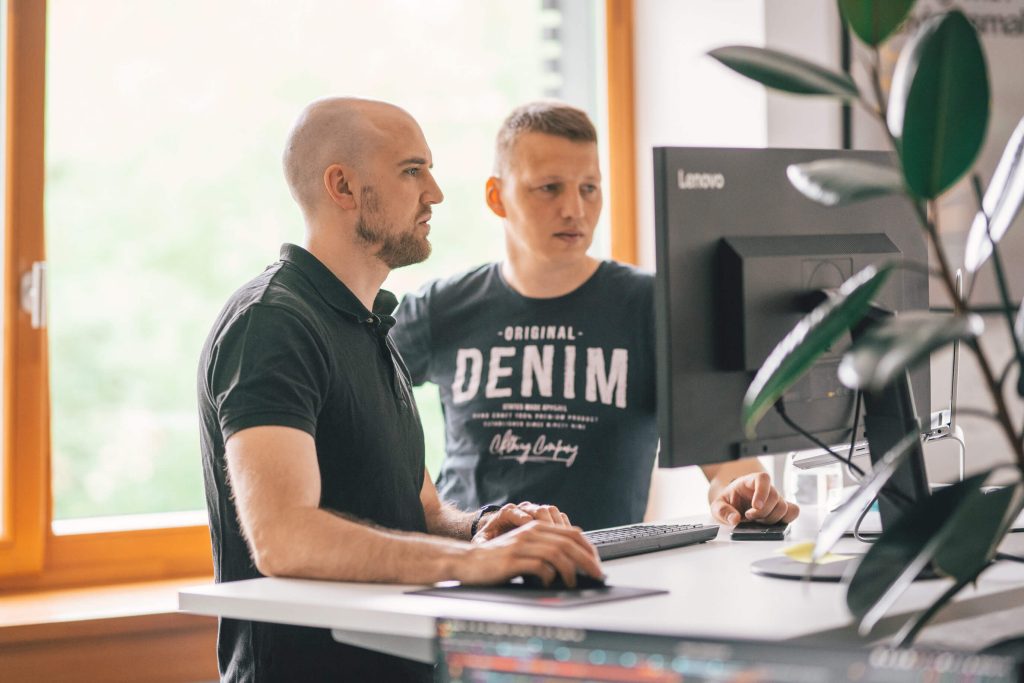
1. For payroll purposes
As passionate as we are about the work that we do, at the end of the day, one of the most crucial things for every employee is the question of how much money they’ll have earned after putting in their hours of hard work. To compensate your team members fairly, it’s crucial that your HR and accounting departments have accurate data to calculate the wages. This is particularly important with team members who are paid on an hourly basis and who might need to be paid extra in case of overtime. And in the case of salaried employees, it’s just as good to know that they are meeting the overall work hours requirements – neither slacking off nor overexerting themselves.
2. To accurately bill your customers
If your work consists of project-based work for customers where you have to charge them for your team’s hours, tracking employee hours is essential. With the tracked time data at your disposal, you can bill your clients accurately down to the minute. Time tracking information gathered in an app can also serve as proof of work – you can show your clients exactly how long each team member worked on a particular aspect of the project or when work was started. Additionally, tracking the hours you’ve spent on one project can help you create a more accurate estimate the next time you’re dealing with something similar.
3. For decisions about personnel changes
Although that’s never a pleasant conversation to have, sometimes it’s necessary to let people go. And if the issue at heart is their work performance, it’s a good idea to have specific data on hand to prove that the decision was not made based on guesswork or personal biases. If someone is consistently late for their shifts or skipping out early, an app that tracks employee hours will make this pattern of infractions clear. On the other hand, if you’re looking for someone to promote, apps that track workers’ productivity and performance will greatly help in the decision-making process.

4. To gain insights into your team’s workflow
It’s also a question of not just individual performance but also how your team tends to work as a whole. For managers, it’s crucial to know how to plan the team’s workflow and resources so that the job gets done promptly and efficiently. If you track employee hours, it’ll be easier for you to identify the gaps in the system that need to be addressed. You may notice that at certain times people tend to stay longer than their indicated shifts simply because their colleagues need help with the workload. This might suggest that another team member is required there at that time, and you need to plan an extra shift.
5. For resource planning
Keeping track of your employees’ working patterns also helps you immensely with organizing your company life and planning expenses. You might realize that it may be time to downsize your office simply because people work more from home. Or you may need to make sure that the office snack supplies are at higher levels during certain days of the week because that’s when people tend to come in. Knowing how many people are at a certain location and at what times can even help you estimate utility costs for the future, allowing budgeting better.
6. To comply with regulations
Depending on the work your team does and where your business is located, you might be obligated to observe certain labor regulations (like overtime pay, total work hours, etc.). To make sure you’re compliant with the rules, you need an accurate way to track employee hours; this data will also serve as proof in case of a dispute. Meanwhile, employees can rest assured that all their hard work will be compensated fairly and that it’s all logged and documented.
7. To prevent burnout
Keeping an eye out on your employees and what they’re doing isn’t just about your company’s bottom line – as a manager, you also need to ensure that no one’s overworked and risking burnout. Employee time tracking will be particularly useful in this case when you’re dealing with remote teams. You can easily notice if someone’s staying way past their hours at the office; but it’s much harder to spot if they’re overworking themselves from home. Working from home, the boundaries between your work and private life can blend too much. So employee hours trackers are here to save you – make sure your teammates maintain a healthy work-life balance and don’t push themselves too hard, which will be highly counterproductive in the long run.

Want your business to thrive?
Using time management software is a smart way to optimize business costs.
How to track employee hours – manual vs. automatic methods
You can keep track of the hours your employees work in different ways – you can ask everyone to log them manually or use software that will do it for you automatically. Depending on the type of work that your company does, one method will be more suitable for you. Or perhaps you need a solution that accommodates different types of teams. The good news is that there are plenty of choices out there, so it’s just a matter of defining what exactly you need.
So let’s look at the best apps to track employee hours in different use cases.
1. Excel – if you’re looking for the quickest and simplest manual solution

We’re all familiar with Excel spreadsheets – this deceptively simple yet extremely powerful and versatile tool can also serve as an app to keep track of employee hours. You can set up a sheet where employees have to log their work hours, indicating their arrival and departure times, how long they worked on a particular task, when they took breaks, or any other metric you’re interested in keeping track of. You don’t even need to start creating the file from scratch – there are ready-made Excel templates available that you can take and adjust to your specific needs.
The drawback with manual time tracking is that the data precision is entirely reliant on how diligent you and your team are about logging hours. It’s also a system that’s much easier to cheat than automatic solutions. However, if you’re looking for something easily adaptable and with a familiar interface, the good old Excel sheet can get the job done.
2. DeskTime – an all-in-one time tracking system that also measures productivity
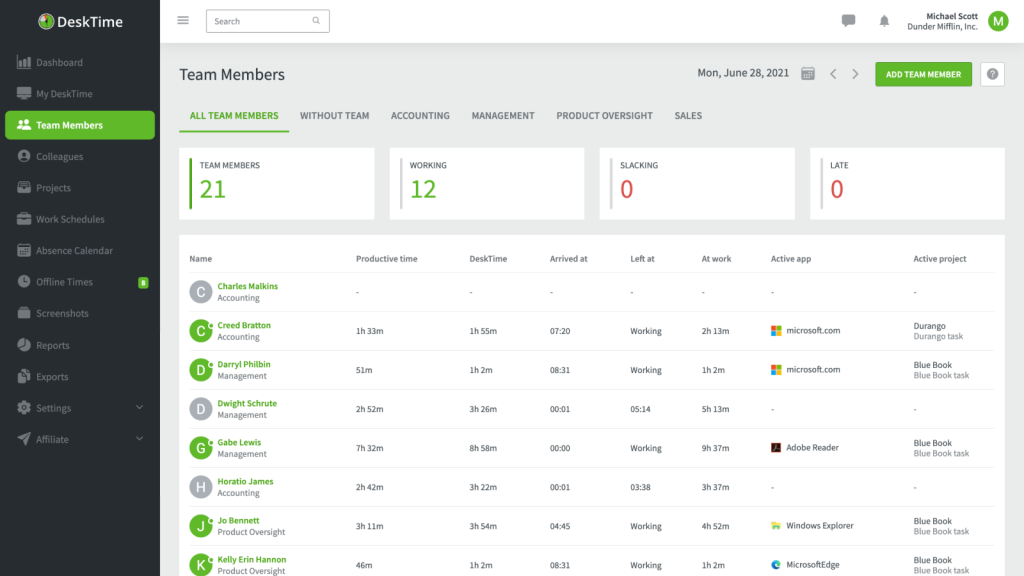
If you’re looking for a more automated solution with minimum manual data entry requirements, you should explore the options offered by software like DeskTime. It’s a time tracking tool that not only counts your team’s work hours (with a down-to-the-second precision) but also can measure everyone’s productivity, help you track the time spent on specific tasks, remind everyone to take regular breaks, plan schedules, vacation times, and do much, much more. When it comes to tracking work hours, the DeskTime employee hours tracker can mark your arrival and departure times automatically – it starts the moment you turn off your computer and stops tracking time when you shut down your device.
Of course, this kind of app will be suitable primarily for teams that do most of their work on their computers. It’s still possible to use them for offline work (many of these solutions, including DeskTime, offer mobile versions of their tool as well), but they won’t be able to live up to their full potential in this case, and you might need to look into different solutions instead.
3. Jibble – a clock-in system suitable for service industries
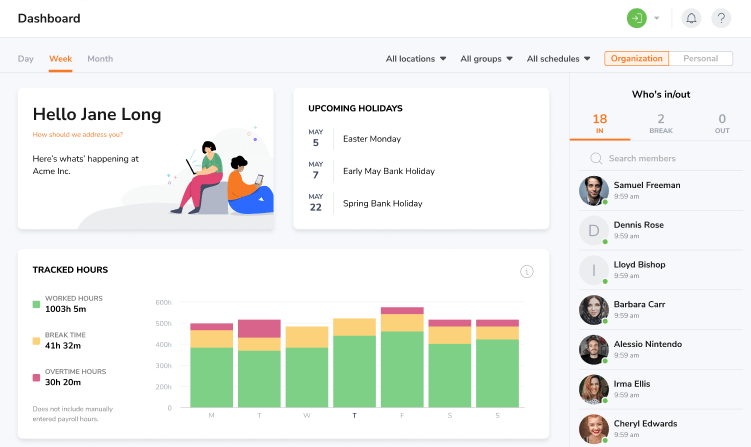
For teams that primarily work in shifts and whose jobs do not require employees to sit at their desks and work on computers, apps like Jibble will provide suitable solutions to track offline employee hours. Jibble, which can be used from various devices, requires employees to log their arrival time and sign out when they leave. You can set up a device to serve as a kiosk – a single device that everyone uses to clock in; you can even set up facial recognition for extra assurance that no buddy punching is going on.
These types of apps to track employee hours will offer other useful features that you can take advantage of; typically, they will also come with shift scheduling solutions to help you efficiently plan your workforce. It can also help you plan vacation time, log other types of absences, and more. Plus, the time tracking reports will make payroll much less of a hassle.
4. Hubstaff – a GPS time tracking solution for teams on the go
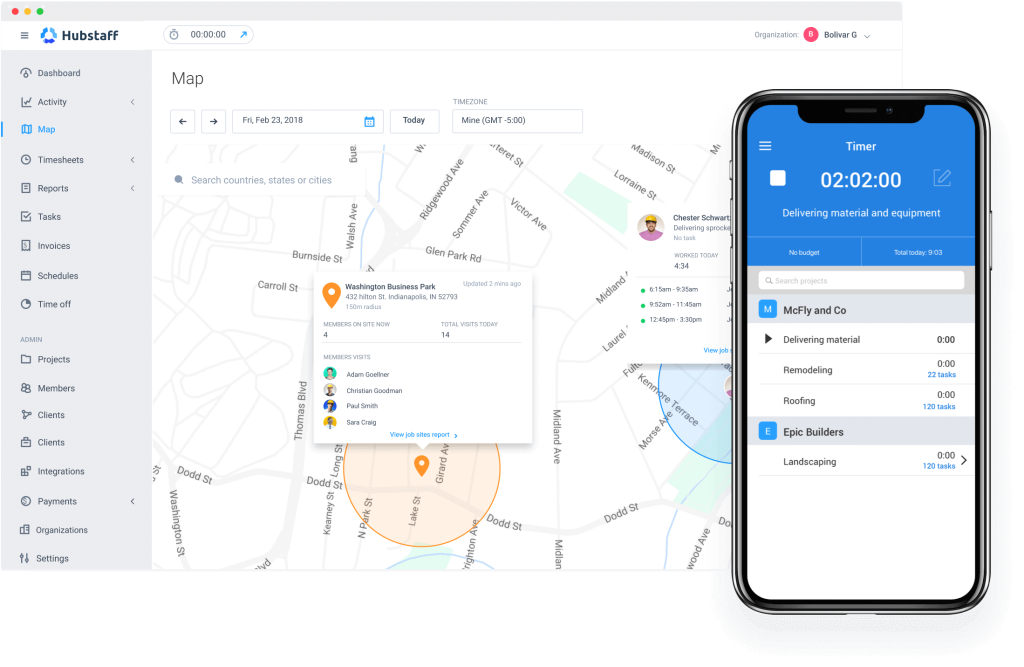
But even if you’re not sitting in front of a computer, that still doesn’t mean that you’re always working in the same spot – some jobs take you from one location to another, in which case you might benefit from an employee hours tracker that also offers GPS tracking, such as Hubstaff. This way, you can not only know when and for how long your employees are on the clock, but you can also make sure they are at the location where they’re supposed to be.
Apps like Hubstaff will often offer not just simple GPS tracking, which lets you see employee location, but you can also set up geofences. If there are specific sites where your employees have to show up, a geofence system can automatically clock them in the moment they arrive at the location. Tracking employee hours with this feature can again help you prevent buddy punching and other attempts to cheat the system.
5. ClickUp – for project-based time tracking
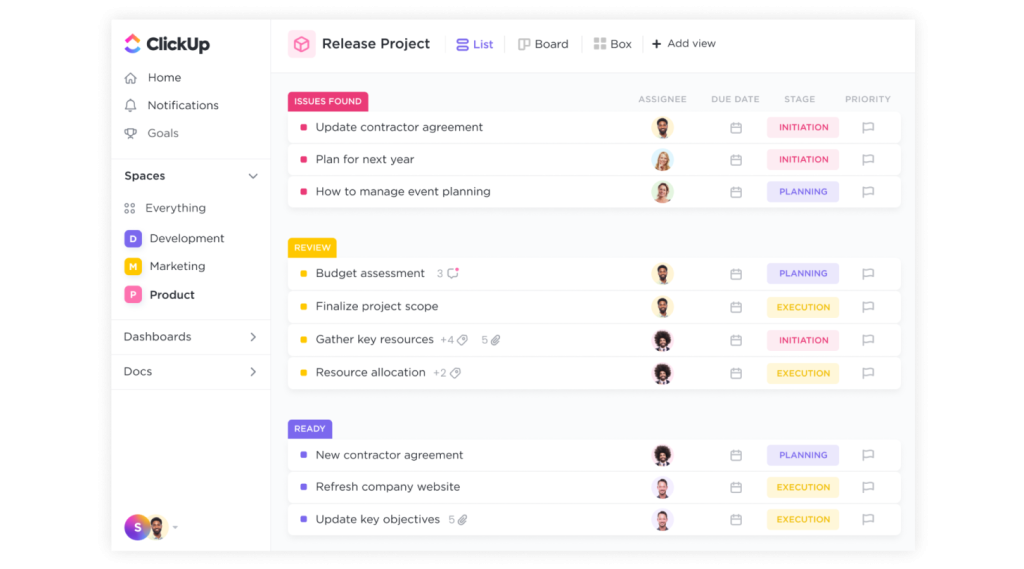
If your work is primarily project-based, and you need to know precisely how much time has gone into a particular task for a specific project, then solutions like ClickUp will work the best for you. This app to keep track of employee hours lets everyone on your team add up the time spent working on tasks, letting you see the scope of the project and its progress in real-time. This way, you can accurately bill your clients based on the amount of work done; you can also use the data from one project to help plan a similar one in the future – you’ll be able to see how much time you should allocate for each part of the project, how many people should be involved, etc.
ClickUp, like many other project time tracking tools, also offers a lot of other project management features that you can take advantage of (providing feedback in the app, whiteboards for planning, etc.); in the end, it might even make sense to move all of your project management to this one app instead of switching between platforms, which inevitably eats up some of your time.

Finally – how to get your team on board with tracking employee hours
While the decision to track employee hours seems like a no-brainer from the employer’s perspective, employees might feel apprehensive about it. So when you’re introducing a time tracker to your team, make sure that you highlight the benefits that your employees will gain as well.
Employee hours trackers will help see everyone’s hard work even clearer; accurate time tracking data means that all of the extra work will show up in the data, and you can compensate it accordingly – overtime will not go unnoticed, or if someone’s taken too much on their plate, the data will indicate that you should distribute duties differently.
You can also use the tracked time to reward your top performers in some way. If you see someone go above and beyond, they surely deserve some recognition from the top. At the end of the day, transparency at the workplace is key – accurate time tracking data will ensure a level playing field for everyone.
It’s also crucial to choose the best app to track employee hours for your team; consider the type of work you do and look up the solution with features that will help you gather the most valuable data. And once you’ve started tracking time, there’s no turning back – the benefits will make themselves clear right away.
Did you find this article useful? Give it a clap!
Psst! You can clap more than once if you really loved it 🙂